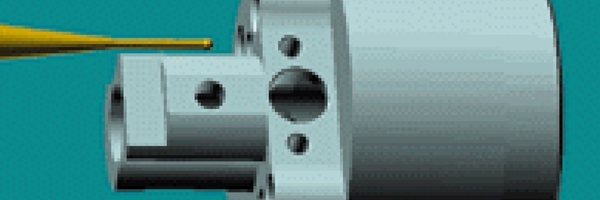Inspecting the Inspector
You probably associate the name Renishaw with excellence in metrology—and you have likely used their probes. Located in Wotton-under-Edge, a sleepy Cotswold village in West England, this innovative company is a firm believer in the benefits of NC simulation/verification and makes extensive use of its own products.
A good example is Renishaw’s Automated Milling and Turning Inspection Center (RAMTIC). RAMTIC is used to manufacture the many small prismatic parts used in inspection probes and other group products. VERICUT plays an integral role in the success of this leading-edge manufacturing engineering innovation. Renishaw’s main challenge is to keep production rates high enough to meet customer demands. The company has responded by achieving 120 production hours a week per CNC machine tool and a manufacturing lead time of 48 hours or less. The complete RAMTIC methodology involves CAD solid modeling, CNC programming, NC simulation and verification, multi-part indexing, fixturing, pallet changing, unmanned machining and in-cycle gauging.
The process starts when the probe is designed in Unigraphics (UG). The model is constructed to net tolerance. ‘Gauge points’ are created on the model with tolerance and design information. No hard copy drawings are produced.
The part is programmed for machining in UG. A specially developed GRIP program (UG’s macro language) is used to generate an in-cycle gauging sequence using the ‘gauge points.’ The sequence ensures that critical features are inspected for each tool offset. The machining cycle, including the in-cycle gauging sequence, is checked using VERICUT. The probing GRIP program produces a tool path using INSERT and IGNORE commands so motion is processed by VERICUT, but ignored by the post-processor. The inspection probe is created as a tool in VERICUT so the complete in- cycle gauging sequence is checked for collisions.
Component stock is then loaded onto a three-head indexer. The fixture is part of a carousel which contains the multiple components and the pre-set tools required for the production run. Renishaw uses seven Yamazaki vertical CNC machines that have been modified with additional pallet changers to accept the multi-fixture carousels. The pallet is automatically loaded. Before machining, the machine tool is calibrated against a master part on the carousel. The complete machining cycle, including the in-cycle gauging sequence, is performed on only one part. Before production, the control offsets are modified depending on the results of the in-cycle gauging.
Because the complete process is unmanned, VERICUT’s simulation of the machining and in-cycle gauging cycles is extremely important to its success. And RAMTIC has been successful—it has already won several prestigious awards such as Machinery and Production Engineering’s ‘Innovative Production Engineering’ and Metalworking Production’s ‘Best Manufacturing System.’
 Germany
Germany Italy
Italy USA
USA South Korea
South Korea UK
UK India
India France
France China
China Japan
Japan
